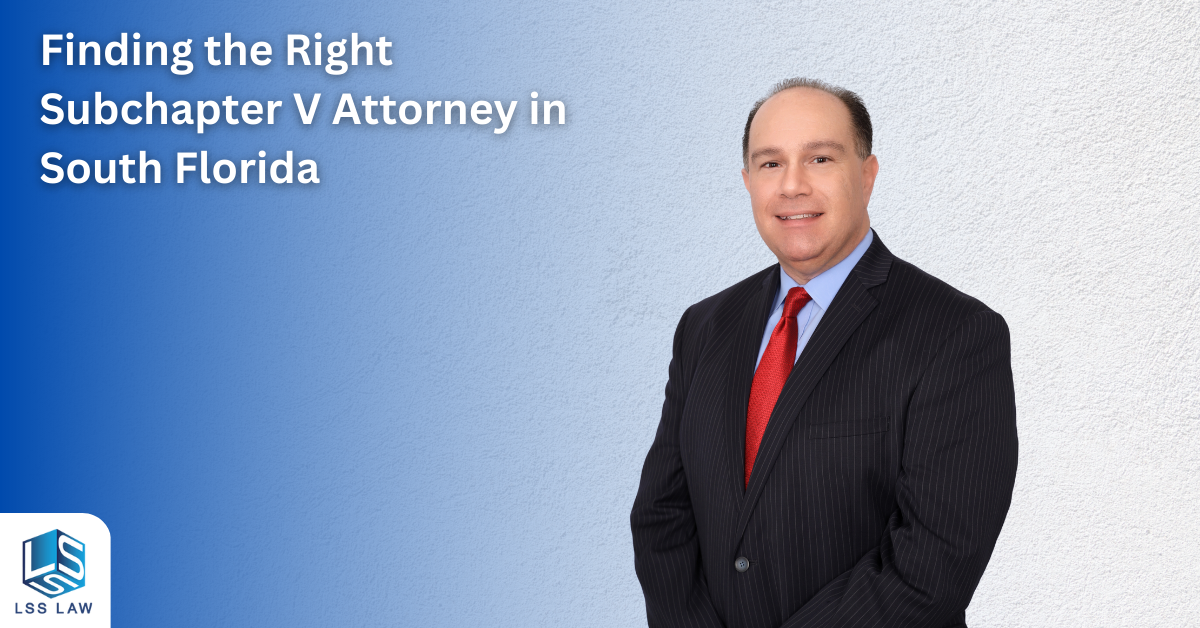Owning a small business can be rewarding, but it can also come with its fair share of challenges, especially when facing financial difficulties. If you’re a small business owner in Florida struggling with debt, you may be considering bankruptcy as a solution. One option you might not be aware of is Subchapter 5 bankruptcy, which can provide eligible businesses a streamlined and cost-effective approach to business debt relief. In this article, we’ll explore what Subchapter 5 bankruptcy entails, how it differs from traditional Chapter 11 bankruptcy, and how it can benefit small businesses in Florida.
All About Subchapter 5 Bankruptcy

Subchapter 5 bankruptcy, also known as Subchapter V of Chapter 11, was introduced under the Small Business Reorganization Act (SBRA) of 2019. This relatively new subchapter was specifically designed to address the unique needs of financially distressed small businesses and provide a more efficient and affordable path to reorganization. The goal of this legislation is to help small businesses overcome their financial challenges and continue operating, ultimately preserving jobs and contributing to the local economy.
How Subchapter 5 Bankruptcy Differs from Traditional Chapter 11
While both traditional Chapter 11 and Subchapter 5 bankruptcy are both types of reorganization bankruptcy and allow for continued business operations, there are some key differences between the two, particularly when it comes to the bankruptcy process and requirements.
1. Eligibility: Subchapter 5 bankruptcy is specifically designed for small business debtors with less than $7.5 million in debt. Traditional Chapter 11 bankruptcy, on the other hand, is available to businesses of all sizes, regardless of their debt levels. See more details on eligibility below.
2. Simplified Process: The Subchapter 5 bankruptcy process is streamlined compared to traditional Chapter 11, with fewer reporting requirements, fewer administrative expenses, and a more straightforward reorganization plan confirmation process. This can result in reduced legal fees and a faster resolution for small business owners.
3. Debtor Retains Control: In most Subchapter 5 bankruptcy cases, the debtor retains control of their business operations and assets as a “debtor in possession.”
4. No Disclosure Statement: Unlike traditional Chapter 11 bankruptcy, Subchapter 5 does not require a detailed disclosure statement to be filed with the bankruptcy court. This can save small business owners time and money in preparing and submitting the necessary documents.
5. Expedited Confirmation Process: Subchapter 5 bankruptcy allows for a faster reorganization plan confirmation process, with the debtor having only 90 days to file their plan. This can help small businesses get back on track more quickly and with less disruption to their ongoing operations.
The Benefits of Subchapter 5 Bankruptcy for Small Businesses in Florida

For eligible small businesses in Florida, Chapter 5 bankruptcy has several important advantages over traditional Chapter 11 bankruptcy:
- Lower Costs: The streamlined process and reduced reporting requirements can result in lower administrative costs and legal fees for small business owners.
- Greater Control: By allowing the debtor to retain control of their business operations and assets, Subchapter 5 bankruptcy can provide a sense of stability and continuity for both the business owner and their employees.
- Faster Resolution: The expedited confirmation process can help small businesses overcome their financial challenges more quickly, allowing them to focus on rebuilding and growing their business.
- Increased Flexibility: Subchapter 5 bankruptcy provides small business owners with more flexibility in negotiating with creditors and restructuring their debts, ultimately improving their chances of a successful reorganization.
If you’re a small business owner in Florida facing financial difficulties, it’s important to explore all of your debt relief options. Subchapter 5 bankruptcy may offer a more streamlined and cost-effective solution for your business, but it’s crucial to consult with an experienced bankruptcy attorney to determine the best course of action for your unique situation. With the right guidance and support, you can overcome your financial challenges and secure a brighter future for your business.
The Role of a Small Business Debtor in Subchapter 5 Bankruptcy

In a Subchapter 5 bankruptcy case, the small business debtor plays a crucial role in the reorganization process. Unlike traditional Chapter 11, where a trustee is appointed to oversee the debtor’s operations, in most Subchapter 5 cases, the debtor retains control of their business as a “debtor in possession.” This means that the small business owner remains responsible for managing their business activities, making decisions about the sale of assets, and negotiating with creditors during the bankruptcy process.
One of the primary responsibilities of a small business debtor in Subchapter 5 bankruptcy is to develop a feasible plan of reorganization with the help of the appointed trustee. This plan must outline how the debtor intends to repay their unsecured debt and provide for continued business operations. The plan must be submitted to the bankruptcy court within 90 days of the bankruptcy filing, and it must be approved by the court before it can be implemented.
Another important responsibility of the small business debtor is to provide regular financial reports to the United States Trustee during the bankruptcy process. These reports must include information about the debtor’s income, expenses, and assets, as well as any changes to their business operations or financial situation. Being transparent and providing accurate financial information can help ensure a smoother bankruptcy process and increase the chances of a successful bankruptcy.
How Subchapter 5 Bankruptcy Can Improve a Small Business’s Credit
One common concern among small business owners considering bankruptcy is the potential impact on their credit. While it’s true that filing for bankruptcy can temporarily lower a business’s credit score, Subchapter 5 bankruptcy can actually help small businesses rebuild their credit over time. By successfully reorganizing their debts and demonstrating a commitment to repaying creditors, small business owners can gradually improve their credit standing.
In fact, many small businesses that successfully complete a Subchapter 5 reorganization find that their credit scores improve within a few years. This is because the bankruptcy process allows them to address their financial difficulties and establish a more sustainable financial situation, making them less of a risk to lenders and other creditors. By following the recommendations of their bankruptcy attorney and making timely payments under their reorganization plan, small business owners can work to rebuild their credit and regain the trust of lenders and suppliers.
Finding the Right Bankruptcy Attorney for Your Small Business

Navigating the complexities of Subchapter 5 bankruptcy can be challenging, which is why it’s essential for small business owners to seek the guidance of an experienced bankruptcy attorney. A knowledgeable attorney can help you determine whether Subchapter 5 bankruptcy is the right solution for your business, guide you through the bankruptcy process, and ensure that your reorganization plan is feasible and compliant with the bankruptcy code.
When searching for a bankruptcy attorney, look for someone who specializes in Subchapter 5 and has a strong track record of helping small businesses successfully reorganize their debts. It’s also important to find an attorney who understands the unique challenges faced by small business owners in Florida and can provide personalized advice and support throughout the bankruptcy process. By partnering with the right attorney, you can increase your chances of a successful reorganization and secure a brighter future for your small business.
The Role of Unsecured Creditors in Subchapter 5 Bankruptcy
Unsecured creditors play an important role in the Subchapter 5 bankruptcy process. These creditors, who do not have collateral securing their claims, are typically entitled to a meaningful recovery under the debtor’s plan. In a Subchapter 5 bankruptcy case, unsecured creditors are often required to accept reasonable concessions in order to facilitate the reorganization of the small business debtor.
In some cases, the court may appoint creditors to an official committee that represents the interests of all unsecured creditors in the bankruptcy case. This committee can negotiate with the small business debtor and participate in the development of the reorganization plan. However, this is less common in Subchapter 5 bankruptcy, as the streamlined process is designed to reduce administrative expenses and expedite the reorganization process.
While unsecured creditors may need to accept some concessions in a Subchapter 5 bankruptcy, the process can ultimately benefit both the small business debtor and their creditors by facilitating a more efficient and cost-effective reorganization, allowing the business to continue its operations and repay its debts over time.
The Importance of Continued Business Operations in Subchapter 5 Bankruptcy
One of the primary goals of Subchapter 5 bankruptcy is to allow small businesses to reorganize their debts while continuing their business operations. This is essential for preserving jobs, maintaining relationships with suppliers and customers, and ultimately ensuring the long-term viability of the business.
During the Subchapter 5 bankruptcy process, the small business must continue to operate and generate revenue in order to make plan payments to repay their creditors. This may require the debtor to make strategic changes to their business model, such as renegotiating contracts, consolidating underperforming locations, or implementing cost-saving measures.
By focusing on continued business operations and working closely with a bankruptcy attorney to develop a feasible reorganization plan, small business owners can increase their chances of successfully emerging from Subchapter 5 bankruptcy with a stronger, more sustainable business.
The Role of Equity Holders in Subchapter 5 Bankruptcy
Equity holders, such as shareholders or partners in a small business, can also be affected by a Subchapter 5 bankruptcy filing. Under the Small Business Reorganization Act, equity holders may be required to contribute new value to the business in order to retain their equity interest, especially if their existing equity interest is deemed to be of minimal value or if the debtor’s reorganization plan does not provide for the full repayment of unsecured debt.
In some cases, equity holders may need to negotiate with the small business debtor and other creditors to reach a consensus on the terms of the reorganization plan. By working collaboratively with the debtor and other stakeholders, equity holders can help facilitate a successful reorganization and protect their investment in the business.
The Benefits of a Streamlined Repayment Plan in Subchapter 5 Bankruptcy
A key feature of Subchapter 5 bankruptcy is the streamlined repayment plan, which is designed to provide a more efficient and cost-effective path to reorganization for small businesses. This plan outlines how the debtor will use projected disposable income to repay their creditors over a specified period, typically three to five years.
Under Subchapter 5, this plan does not need to be approved by creditors; it needs to pay the creditors as much as they would in a Chapter 7 (liquidation) bankruptcy, and it must be fair and equitable. The court must also agree that the debtor can keep up with the payments. This allows for a more simplified plan confirmation process, which can save time and reduce administrative costs for the debtor.
By focusing on a realistic and achievable repayment plan, small business owners can increase their chances of successfully emerging from Subchapter 5 bankruptcy with a stronger, more sustainable business. This will ultimately benefit both the small business debtor and their creditors by allowing the business to continue its operations and repay its debts over time.
The Role of the Bankruptcy Court in Chapter 5 Bankruptcy
In a Subchapter 5 bankruptcy case, the bankruptcy court plays a crucial role in overseeing the reorganization process and ensuring that the debtor complies with the requirements of the Bankruptcy Code. The court is responsible for reviewing and approving the debtor’s reorganization plan, as well as monitoring the debtor’s progress throughout the bankruptcy process.
The bankruptcy court also has the authority to grant extensions for the debtor to file their reorganization plan, which can provide much-needed flexibility. Additionally, the court can approve the debtor’s request to obtain post-petition financing or extend additional credit, which may be necessary for the debtor to continue their business operations during the reorganization process.
Understanding the Requirements for Qualifying as a Small Business Debtor
To be eligible for Chapter 5 bankruptcy, a small business must meet certain criteria under the Bankruptcy Code. These requirements are designed to ensure that this streamlined process is only available to businesses that genuinely need the benefits and protections it offers.
– The business must be engaged in commercial or business activities, excluding primarily the ownership of real property or her primary residence.
– The business’s total non-contingent, liquidated, secured, and unsecured debts must not exceed $7,500,000, excluding debts owed to affiliates or insiders.
– At least 50% of the business’s debts must be related to its business activities, not including debts related to the ownership of real property or her primary residence.
By ensuring that a business qualifies as a small business debtor, the Subchapter 5 bankruptcy process can provide targeted relief to small businesses that need the streamlined reorganization process to regain their financial footing and continue their operations.
Chapter 5 Bankruptcy Small Business FAQ.
What is the main difference between traditional Chapter 11 and Subchapter 5 bankruptcy?
The main difference between traditional Chapter 11 and Subchapter 5 bankruptcy is that Chapter 5 is a streamlined process specifically designed for small businesses. It offers a more efficient and cost-effective way for small business debtors to reorganize their debts and continue their operations.
How does Chapter 5 bankruptcy affect a small business’s credit?
Initially, a bankruptcy filing may negatively impact a small business’s credit, successfully completing the Chapter 5 reorganization process can help rebuild credit over time. As the business repays its debts and demonstrates financial responsibility, its credit rating can improve.
Can a small business continue its operations during Subchapter 5 bankruptcy?
Yes, a small business can continue its normal operations during Chapter 5 bankruptcy. In fact, one of the main goals of Subchapter 5 bankruptcy is to allow financially distressed small businesses to reorganize their debts and continue their operations while working towards financial stability.
How can a small business determine if it qualifies for Subchapter 5 bankruptcy?
To qualify for Subchapter 5 bankruptcy, a small business must meet specific criteria, including having total non-contingent, liquidated, secured, and unsecured debts not exceeding $7,500,000 (excluding debts owed to affiliates or insiders) and having at least 50% of its debts related to its business activities. An experienced bankruptcy attorney can help determine if a business qualifies for Subchapter 5 bankruptcy.
How long does the Subchapter 5 bankruptcy process typically take?
The duration of the Subchapter 5 bankruptcy process can vary depending on the complexity of the debtor’s financial situation and the level of cooperation among the debtor, creditors, and the bankruptcy court. However, the streamlined nature of Subchapter 5 bankruptcy is designed to make the process quicker and more efficient than traditional Chapter 11 bankruptcy.
Contact Us to Learn More About Chapter 11 Subchapter 5 Bankruptcy for Small Businesses

If you’re a small business owner in Florida struggling with debt, don’t hesitate to reach out to our bankruptcy law firm, LSS Law. We’re here to help you understand your options and determine if Subchapter 5 bankruptcy is the right path for your business.
Schedule a Bankruptcy Strategy Session by calling us at 954-466-0541 or emailing us at info@lss.law today. Together, we can work towards removing the financial monkey from your back and opening the door to a brighter future.






